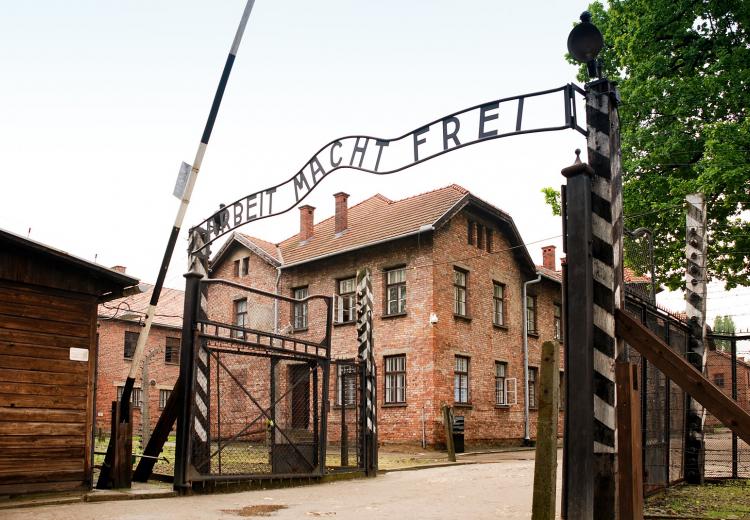Coming of Age in the Holocaust, Coming of Age Now

Entrance to the concentration camp at Auschwitz in Poland.
“Bread, soup - these were my whole life. I was a body. Perhaps less than that even: a starved stomach. The stomach alone was aware of the passage of time.”
― Elie Wiesel, Night
The Holocaust is one of the greatest tragedies in modern history. Its enormity can be difficult for students to comprehend, considering the long history of anti-Semitism across history, the geographic landscape of concentration, labor, and extermination camps, and the psychological scars that live on in the survivors and their families.
A Brief History
Adolf Hitler and the National Socialist German Workers' Party (Nazi Party) came to power in Germany in 1933, however, the long history of anti-semitism across what is now known as Europe dates back centuries. The Holocaust Memorial Museum provides a short video, timeline, and other resources for teaching Jewish history before the 20th century. Within the context of the Holocaust, passage of the Nuremberg Laws in 1935 expedited the systematic purging of Jewish people from jobs, housing, and the removal of other rights with the termination of their status as German citizens.
Kristallnacht, or the "night of broken glass," was when Nazi officers targeted Jewish owned property and people across Germany during the night and into the morning of November 9-10, 1938 (violence was perpetrated beyond the single night in many places). Breaking storefront windows and defacing synagogues, homes, and other Jewish sites, this event is often cited as a turning point in what would ultimately lead to the construction of ghettos and camps across Europe and the genocide known as the Holocaust.
As the Nazi reign of terror extended beyond Germany and persecution of Jewish people, Romas, gay and lesbian people, perceived and acknowledged Socialists and Communists, people with disabilities, and people of Slavic descent were arrested, imprisoned, and killed too. The genocide that occurred between 1941-1945 killed an estimated six million Jewish people and the total number of victims of Nazi tyranny is believed to be 17 million people.
A more comprehensive examination of this period in history is available at the Holocaust Memorial Museum website.
The Curriculum
One way of approaching this topic is for students to hear the testimony of individual survivors. Coming of Age in the Holocaust – Coming of Age Now is a free, interactive curriculum for middle and high-school students and their educators created by the Museum of Jewish Heritage—A Living Memorial to the Holocaust in New York in collaboration with Yad LaYeled – The Ghetto Fighters’ Holocaust and Jewish Resistance Heritage Museum in Israel.
Coming of Age in the Holocaust – Coming of Age Now features individual testimonies of thirteen people who were adolescents during the Holocaust and had some of the same concerns that young people today have. Students follow their stories through the survivors’ words, short video interviews, maps, pictures, a glossary, a timeline, and other instructional content. Students who read all thirteen stories will encounter the Holocaust through the eyes of youth their own age who survived it. Through these survivors they will explore the diversity of experience that took place within it.
The Coming of Age Now curriculum includes twelve stories of Holocaust survivors and one story of an individual who grew up in the British Mandate of Palestine during the same period. Each story reflects unique, individual experiences, and as a group, the stories provide a library of resources for learning about the Holocaust through personal narratives.
Students will reflect on the challenges survivors faced in maintaining their identities, responsibilities they assumed during difficult circumstances, sacrifices they made for others, and lessons they want to impart to the next generation. The curriculum was developed so that by studying the lives of survivors, students will grow in their understanding of the Holocaust and themselves, and develop a deeper sense of what it means to come of age today.
A Sample Survivor’s Story: Elli Friedmann
Elli Friedmann was born in 1931 in Samorin, Czechoslovakia, which was later occupied by Hungary. When the Nazis invaded Hungary, they forced the Jews to live in ghettos. From the ghetto, Elli’s father was taken to a labor camp, while Elli and the rest of her family were deported to Auschwitz. Elli, her mother, and her brother survived the war. Elli ultimately became a professor at the City University of New York and wrote a book about her experience, I Have Lived a Thousand Years: Growing Up in the Holocaust. Click on the different chapters of her story to read the text and click on the videos to watch the survivor testimonies. You can also access all the videos from a particular story in the “Video Testimonies” link.
In addition to the thirteen testimonies, there are a number of teacher guides that offer discussion questions, research activity suggestions, and more resources.
Extending the Lesson
Each survivor story is accompanied a selection of additional resources and project suggestions, which can be completed as an extension of the online activities. The Lesson Plans page provides a collection of resources and questions for teaching about the Holocaust and World War II history.
